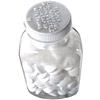Painkiller abuse treated effectively by sustained buprenorphine/naloxone
People addicted to prescription painkillers reduce their opioid abuse when given sustained treatment with the medication buprenorphine plus naloxone (Suboxone), according to research published in Archives of General Psychiatry on Nov 8 and conducted by the National Institute on Drug Abuse (NIDA), part of the National Institutes of Health. The study, which was the first randomised large scale clinical trial using a medication for the treatment of prescription opioid abuse, also showed that the addition of intensive opioid dependence counseling provided no added benefit.
“The study suggests that patients addicted to prescription opioid painkillers can be effectively treated in primary care settings using Suboxone,” said NIDA Director Nora D. Volkow, M.D. “However, once the medication was discontinued, patients had a high rate of relapse—so, more research is needed to determine how to sustain recovery among patients addicted to opioid medications.”
Pain medications are beneficial when used as prescribed, but they have significant abuse liability, especially when taken for non-medical reasons. This study examined whether the FDA-approved medication Suboxone could help combat this growing problem. Suboxone is a combination of buprenorphine to reduce opioid craving plus naloxone, which causes withdrawal symptoms in someone addicted to opioids if Suboxone were taken by a route other than orally, as prescribed. This combination was specifically designed to prevent abuse and diversion of buprenorphine and was one of the first to be eligible for prescribing under the Drug Addiction Treatment Act, which permits specially trained physicians to prescribe certain FDA approved medications for the treatment of opioid addiction.
Most studies examining treatments for opioid dependence have been done with heroin-addicted patients at methadone clinics, so there have been little data on treatment for patients addicted to prescription painkillers, especially in the offices of primary care doctors. To help address this issue, NIDA’s Clinical Trials Network launched the Prescription Opioid Addiction Treatment Study (POATS) in 2007, which took place at 10 treatment sites around the country.
“Despite the tremendous increase in the prevalence of addiction to prescription painkillers, little research has focused on this patient population,” said Roger Weiss, M.D., of Harvard Medical School, Boston, and the lead author of the study. “This is the first large-scale study to examine treatments exclusively for people who were abusing prescription painkiller medications and were treated with buprenorphine-naloxone, which can be prescribed in a physician’s office.”
In the study, more than 600 treatment-seeking outpatients addicted to prescription opioids received Suboxone in combination with brief standard medical management, in which physicians evaluated treatment effectiveness and recommended abstinence and self-help participation. Half of the participants also received varying intensities of addiction counseling as provided by trained substance abuse or mental health professionals.
Results showed that approximately 49 percent of participants reduced prescription painkiller abuse during extended (at least 12-week) Suboxone treatment. This success rate dropped to 8.6 percent once Suboxone was discontinued. Reductions in prescription painkiller abuse were seen regardless of whether or not the patient reported suffering chronic pain, and participants who received intensive addiction counseling did not show better outcomes when compared to those who did not receive this additional counseling.
According to the Substance Abuse and Mental Health Services Administration’s National Survey on Drug Use and Health, an estimated 1.9 million people in the United States meet abuse or dependence criteria for prescription pain relievers. In addition, the Centers for Disease Control and Prevention report that annually, more people die from prescription painkiller overdoses than from heroin and cocaine combined.
(Source: National Institute on Drug Abuse (NIDA): Archives of General Psychiatry)
More information
 | For more information about drugs, including an introduction to pharmacology, generic versus branded drugs, and the meaning of drug schedules and pregnancy categories, see Drugs. |
Dates
Tags
Created by:

 Login
Login














